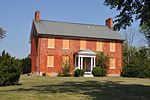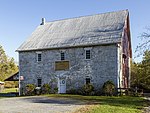Morgan-Gold House
1745 establishments in VirginiaBerkeley County, West Virginia Registered Historic Place stubsGreek Revival houses in West VirginiaHouses completed in 1745Houses completed in 1809 ... and 5 more
Houses in Berkeley County, West VirginiaHouses on the National Register of Historic Places in West VirginiaLog buildings and structures on the National Register of Historic Places in West VirginiaMorgan family of West VirginiaNational Register of Historic Places in Berkeley County, West Virginia

Morgan-Gold House, also known as "Golden Meadows" or the Samuel Gold House, is a historic home located at Bunker Hill, Berkeley County, West Virginia. It is an L-shaped, three-bay, two-story, log dwelling on a stone foundation. The front section was built about 1809, and is a 20 1/2-feet deep and 30 1/2-feet wide block, with a pedimented portico in the Greek Revival style. The rear part of the ell was built about 1745 by David Morgan, son of the Morgan Morgan the first white settler of West Virginia. Also on the property are three log outbuildings and Victorian-era granary.It was listed on the National Register of Historic Places in 1985.
Excerpt from the Wikipedia article Morgan-Gold House (License: CC BY-SA 3.0, Authors, Images).Morgan-Gold House
Runnymeade Road,
Geographical coordinates (GPS) Address Nearby Places Show on map
Geographical coordinates (GPS)
| Latitude | Longitude |
|---|---|
| N 39.332222222222 ° | E -78.077777777778 ° |
Address
Runnymeade Road 1354
25413
West Virginia, United States
Open on Google Maps










